Sensing Time and Chemicals
1/67
There's no tags or description
Looks like no tags are added yet.
Name | Mastery | Learn | Test | Matching | Spaced |
|---|
No study sessions yet.
68 Terms
Endogenous rhythms
regular and cyclical variations of function
not dependent on incoming sensory information
BUT→ can be modulated by sensory information
Advantage of endogenous rhythms
predictive of regular environmental changes
Three major rhythms
circannual→ seasonal reproduction, migration, fat accumulation, dormncy
cicadian→ one a day
circatidal→ 12.4h half a lunar day for marine creature
What are circadian clocks
endogenous 24 hour rhythm
anticipate light levels
match activities to the day/night cycle
Where found?
Ubiquitous
in plants, animals and bacteria
How do they compare to homeostatic feedback control?
exert feed-forward control over effectors
What do they control
sleep/wake cycle
feeding
excretion
temperature
diuresis
blood pressure
What happens if they are left to free run?
become desynchronised
why: intrinsic rhythm is not exactly 24 hours
THEREFORE: need to maintain circadian clock ticking by entrainment
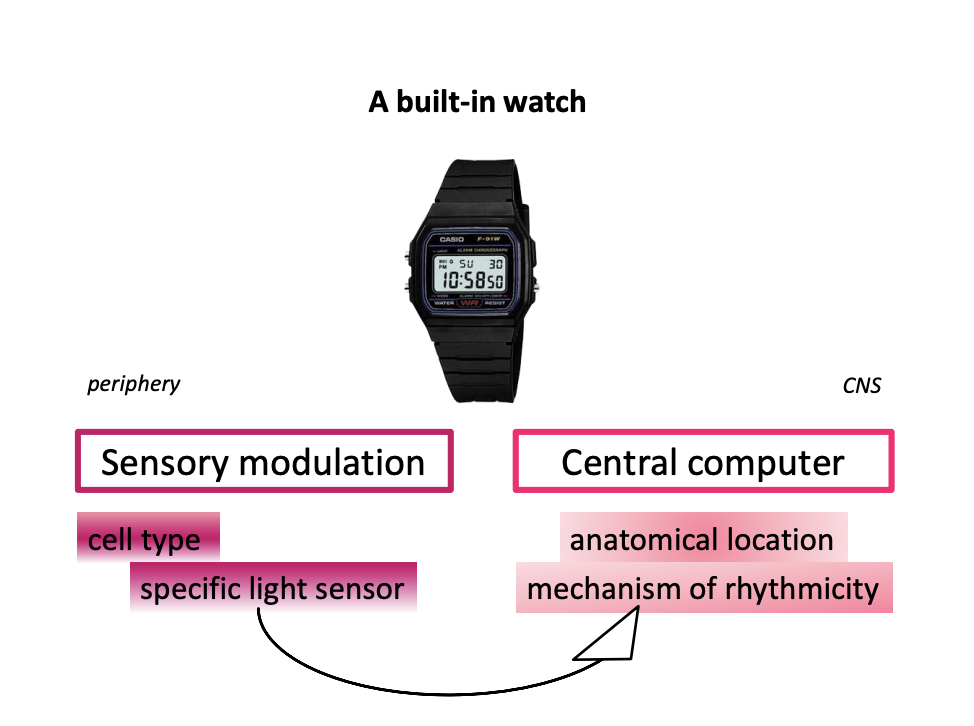
How does the ryhtm entrained?
Not with rods or cones
new photoreceptor: intriniscally photosensitive retinal ganglion cells ipRGCs
contain melaopsin
different kind of opsin
found in the retina
Melanopsin
most closely related to insect r-opsins
than to c-opsins in rods and coes
How does Melanopsin act
Through PLC and TRP channels
Use G-protein signalling cascade
Similar to Drosophila photoreceptors
Where is the master clock in the mammalina brain
Suprchiasmatic nucleus (SCN)
of the hypothalamus
How is this rhyhm made
intrinsic rhythm of electrical activity
around 25 hours
entrained by neural signals from the retina
→ to make it precise 24 hour neural clock
Drives cyclic changes
hormone secretion
sleepiness
How does the clock also deduce the time of year
relative lengths of day and night
→ kind of similar to that in plants!
Why can’t a neural circuit generate the rhythem?
Action potentioals and synaptic events would seem too fast to underlie a slow 24hr cycle
Instead, for the clock you need…
slow cycle of gene expression
and protein synthesis
→ just as in plants
What is the molecular clock
slow build-up of “clock protein”
Clock proteins have a short lifespan
require the acitivity of transciption factors→ e.g CREB (c-AMP response-element binding protein) to be synthestized
When present, the clocl protein acts on the trasncitption factors themselves→ inhibiting them and therefore stopping own production
(summaried next!)
Cascade of the olecular clock
CREB transciption facotr initiates produciton of clock proteins
clock protein inhibit CREB (negative feedback)
Production of clock protein stops
Previously made clock protein degrade
inhibition of CREB is lifted
Trasnciption of clock genes resumes, clock proteins are made, the cycle starts again
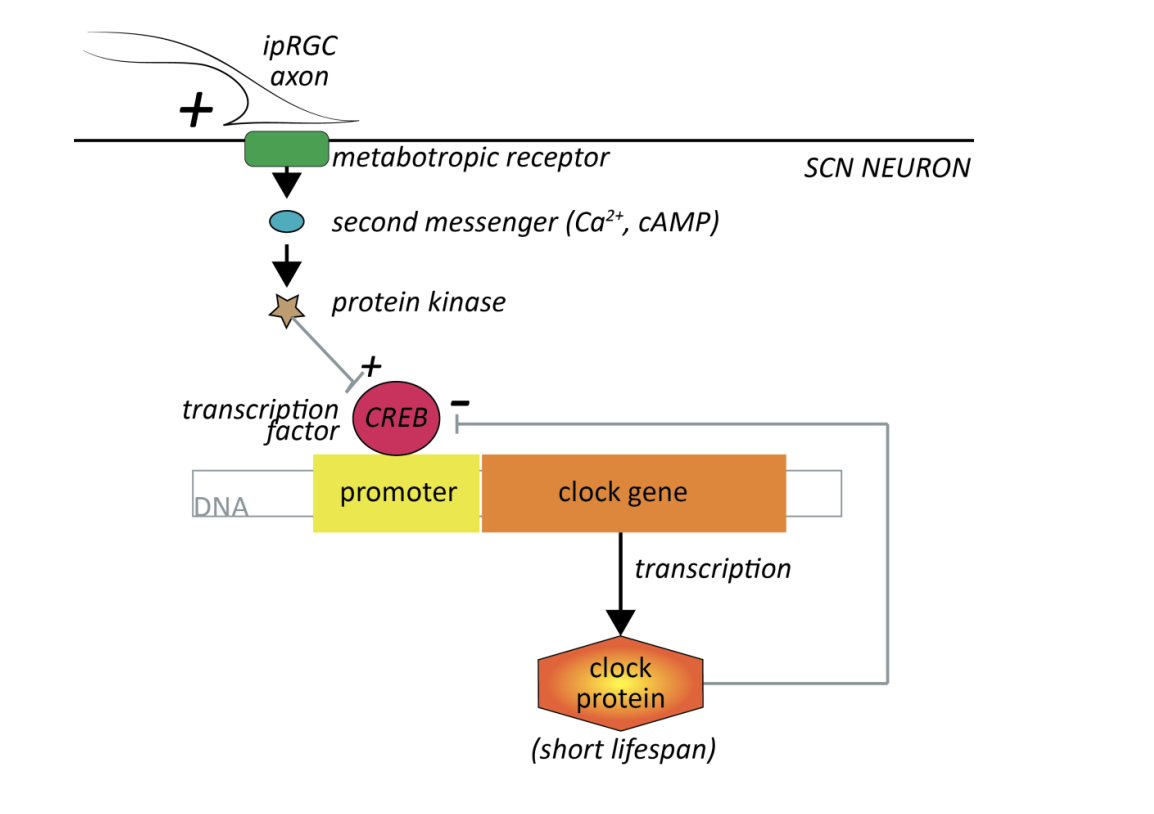
If it was let to free run…
cycle would take 25 hours
→ input of ipRGCs are needed
ipRBC input
activates metabotropic receprots
via second messengers and kinase
Activate CREB
locking the cycle to the actual day-night cycle
Plant vs Animal clocks
Plants:
autonomous in the plant cell
each cell has its own circadian clock
respons directly to light
Animals
in the SCN→ although small animals are more cell-autonomous
Taste and smell in vertebrates vs invertebrates
Vertebrates
Metabotropic receptors mainly
Invertebrates
largely due to direct ionotropic mechanisms
How is transduction initiated in both of these?
physical binding of the chemical molecule
To xbspecific receptor
→ similar to neurotransmitter to postysnaptic receptors
What makes chemical sensing hard to do?
Chemical space is immense
→ Difficult to convery so much information with a limited set of receptors
Gustation
chemical sense that requires physical contact
with source for detection
Olfaction
chemical sense that detect chemicals emanating from a distant source
What functions does taste have?
aversive→ avoid toxic stuff
Attractant→ get nutrition etc
5 distinct taste sub-modalities
sweet
umami
bitter
sour
salt
→ each with its own receptor proteins→ taste receptor cells and transduction mechanism
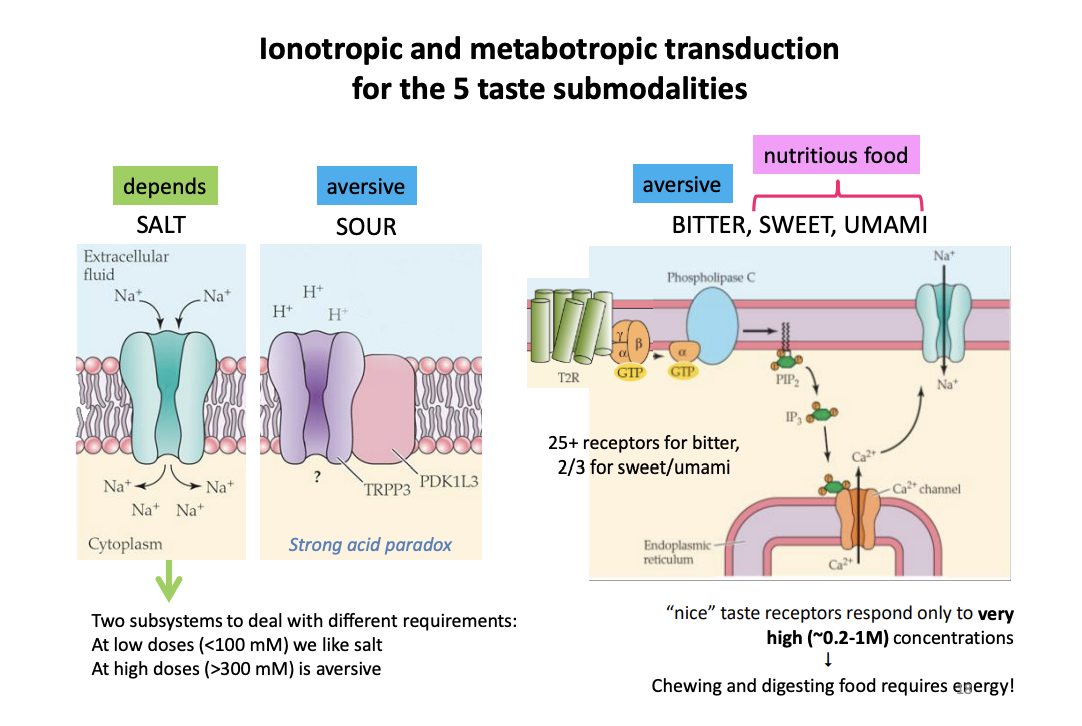
Features of taste receptor cells
short receptors
localised in taste buds
in papillae on the tongue and palate
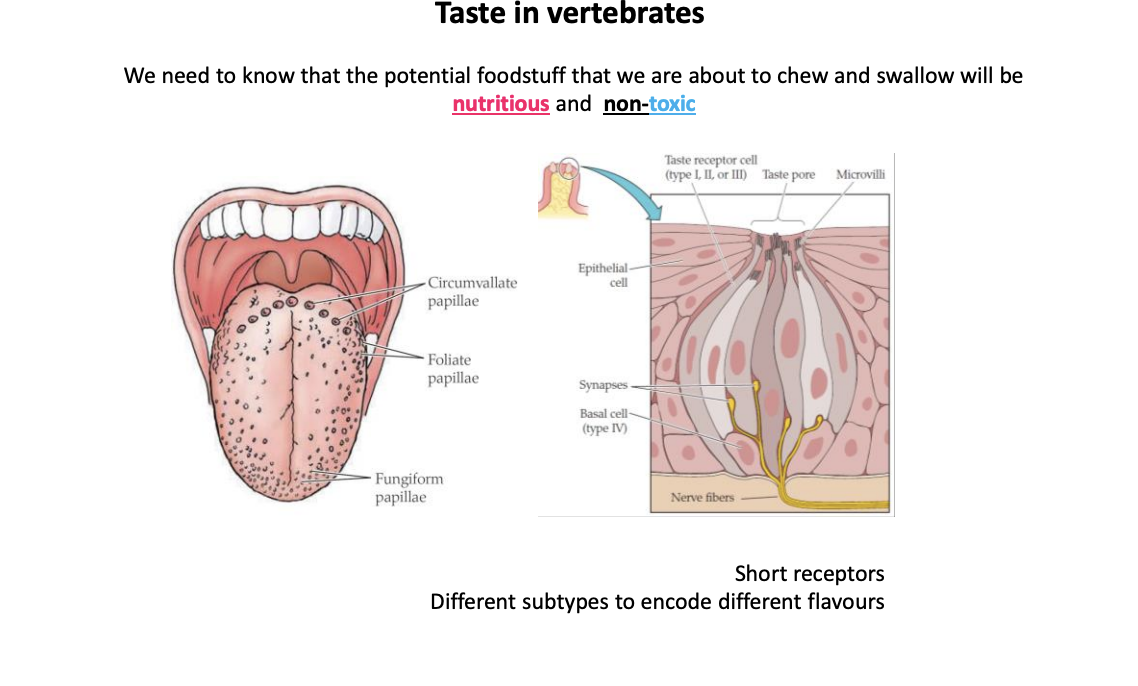
Tasting for good
sweet
umami
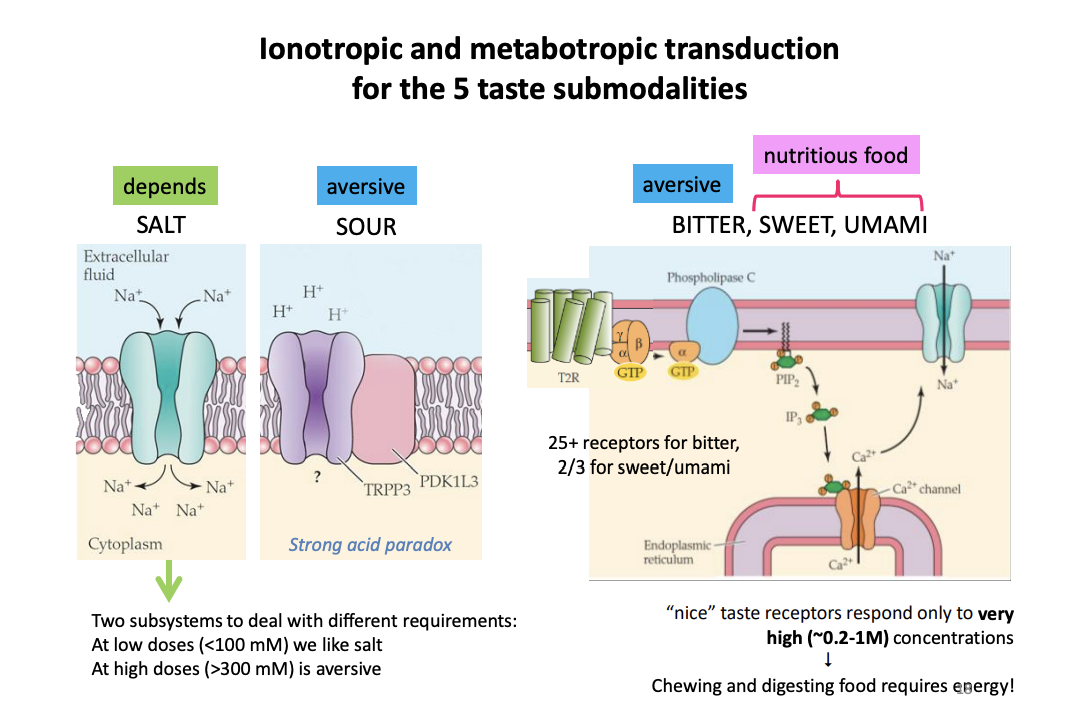
Tasting for bad
bitter
sour
salt
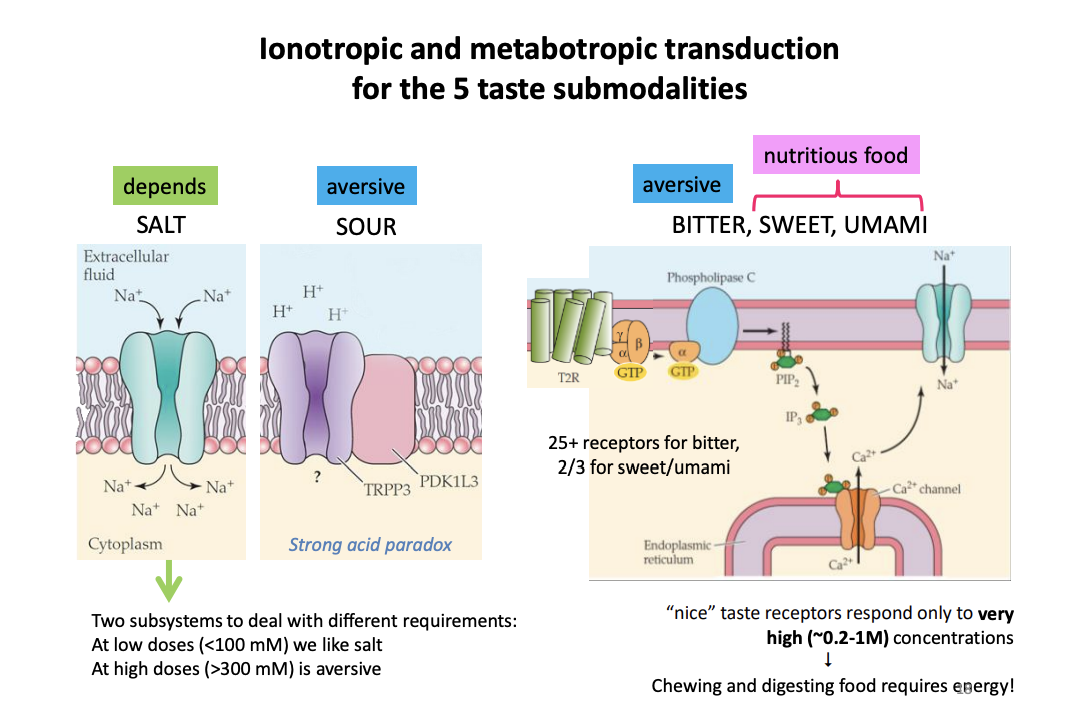
Salt attractive or aversive?
Both
Taste is also strongly informed by
olfaction
Ionotropic taste receptors
salt
sour
How taste salt
Na+ ions flowing into sensory cell
depolarising it
constinutitecely open Na+ channel
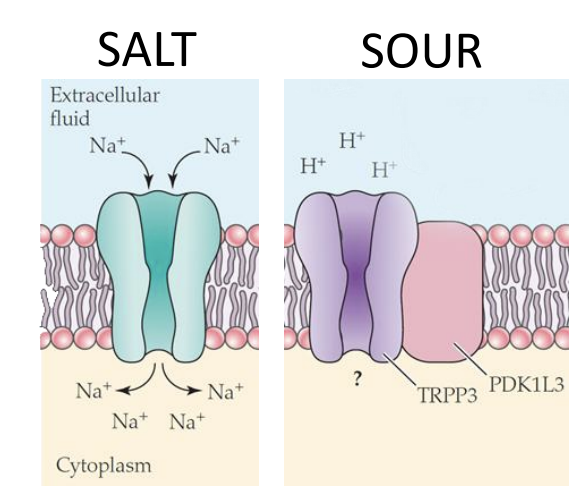
Salt at low levels
We like:
Mediated by Na+ ions floing through epithellal ionotropic channel
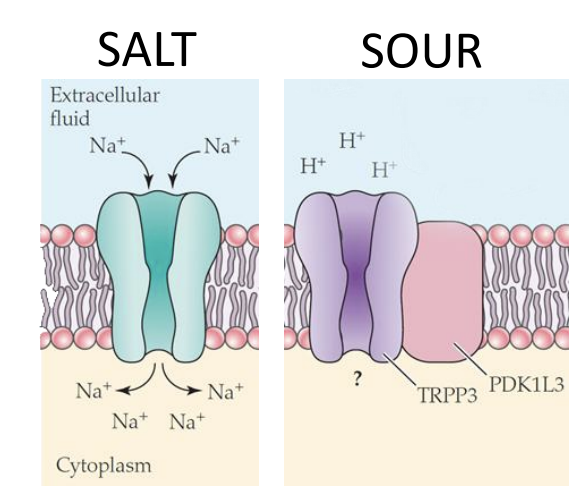
Salt at high concentrations
Uses receptor channel protein for aversive salt
not known
expressed in different cells from those that detect low salt
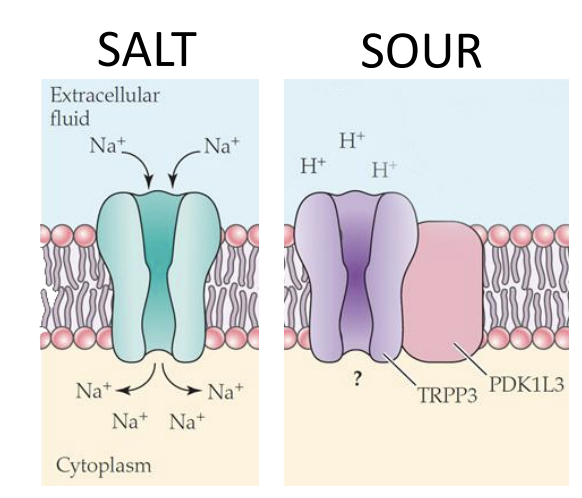
HOw taste sour
undissociated (uncharged) weak organic acids
diffuse freely through the cell membrane
become ionised within the cytoplasm
releasing protons which modulate activity of pH-sensitive ion channels form inside the cell
Weird thing about strong acids?
Do not easily cross the membrane
don’t taste as sour!
Metabotropic taste receptors
Sweet
Umami
bitter
Types of receptors used
All GPCR
share common metabotropic G-protein signalling cascade
How work?
The GPCRs act via another specific G-protein (gustducin)
Actiavtes a phospholipase C enzyme
eventually results in Na+ entry and repolarisation
No. of GPCRs for ‘nice’ vs ‘bitter’
2 for nice→ repond to very high concentrations
25 for bitter→ respond to low concentrations→ small amount might be lethal
As all 25 bitter receptors are expressed in the same cell
we can’t use them to distinguish different bitter tastes
Chemosensation in plants
Can detect leaf volatiles in response to chemicals secreted
e.g aphids or insect eggs
Other plants can sense eaf volatiles→ prepare themselve to resist attack
e.g producing toxins
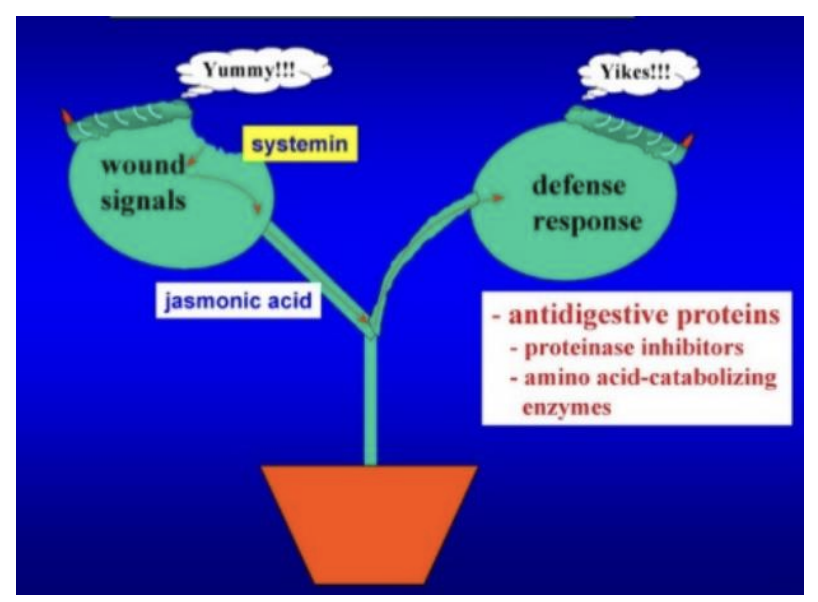
Features of receprot cells for taste and asmall in insects
long receptors
sensory endings embedded in sensory bristles (sensilla)
What happens when volatile odaours/tastants reac the surface of the recpor
reach by diffusing through microscopic pores in the tip or walls of the bristles
Follow the direct ionotropic principle
GCPR in insects?
taste and olfactory resemble GPCR→ they have 7 transmembrane domains
BUT
no homology to vertebrate

Drosophila OR genes in olfactory sensilla
1 family of 50 genes:
expressed in antennae and maxillary palps
2nd family of 60 genes
related to ionotropic glutamtate receptors
presumed to be ionotropigc glutamtate receptos
ionotropic, ligand-gated ion channels
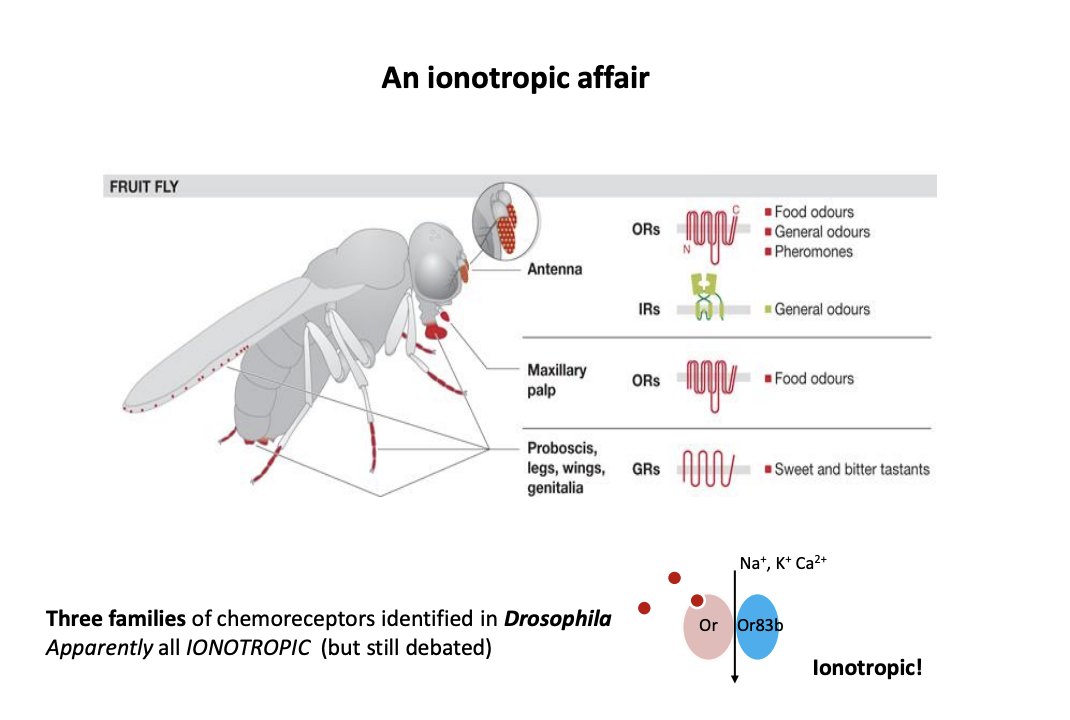
Where are taste receptors expressed in the Drosophila
In the sensilla:
mouthparts→ proboscis
legs
wings
gentitalia
→ good before you put it in yur mouth
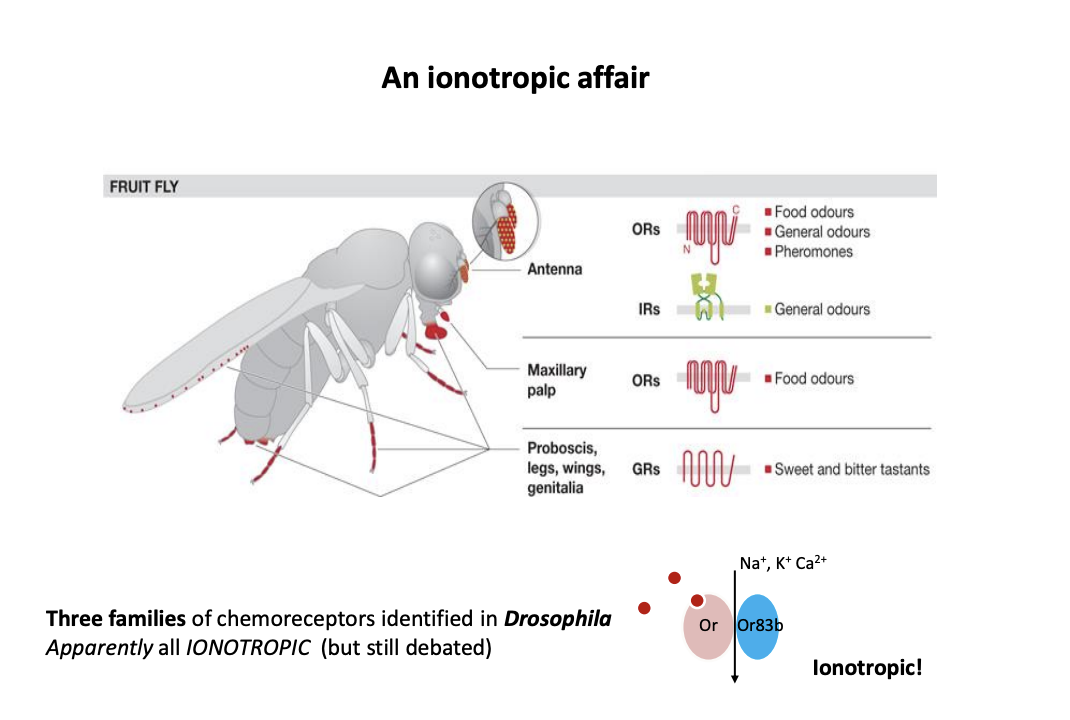
Similariy to taste buds
one chemosensory sensillum has a range of chemorecpetor cells
e.g
sensitive to salt and water
mechanosensory neuron
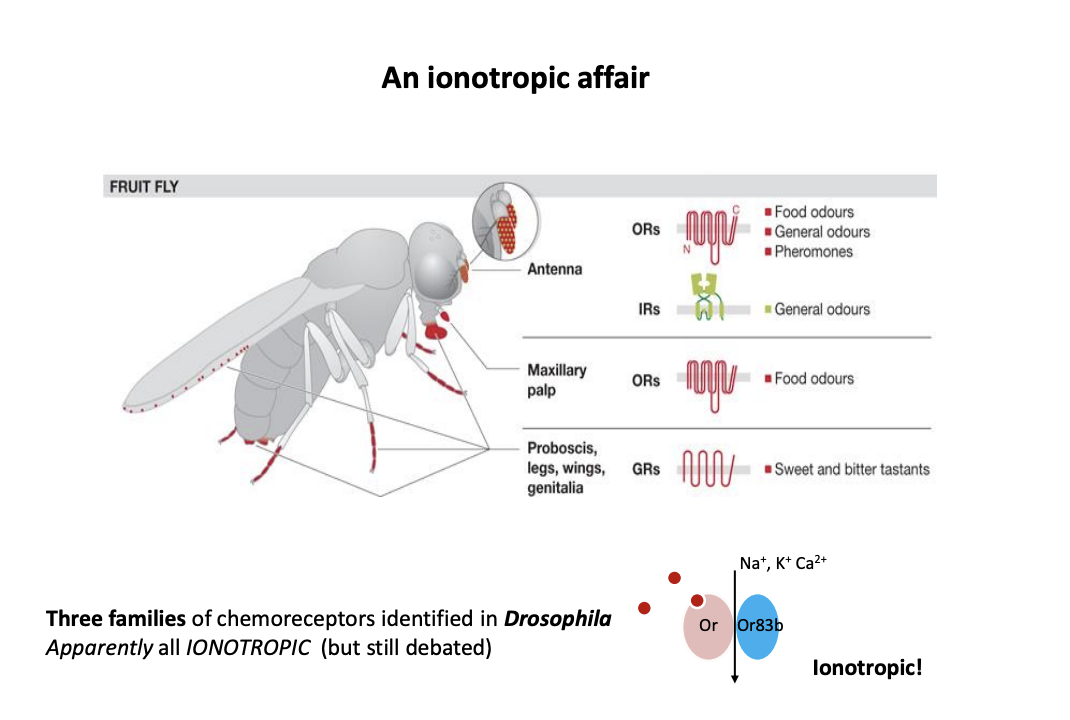
Type of recepors that are taste receptors
also believed to be ionotropic
forming cation channels direclty gated by sugars or bitter compounds
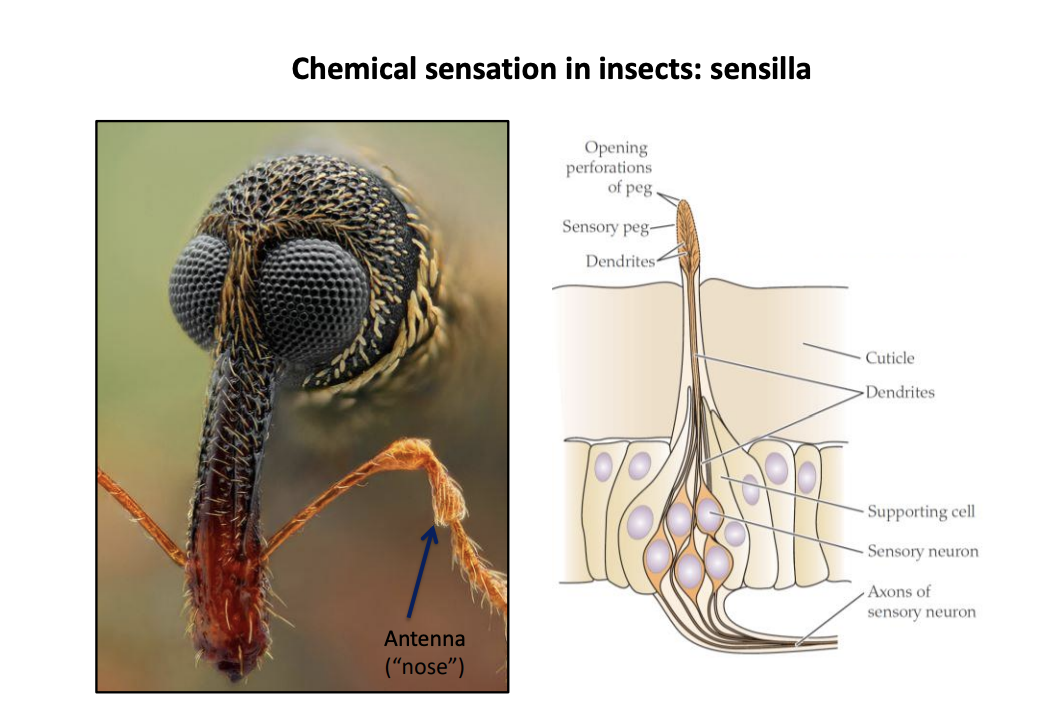
Where is the olfactory epithelium is vertebrates
high in the nasal cavity
contains arounf 5 million olfactory receptors
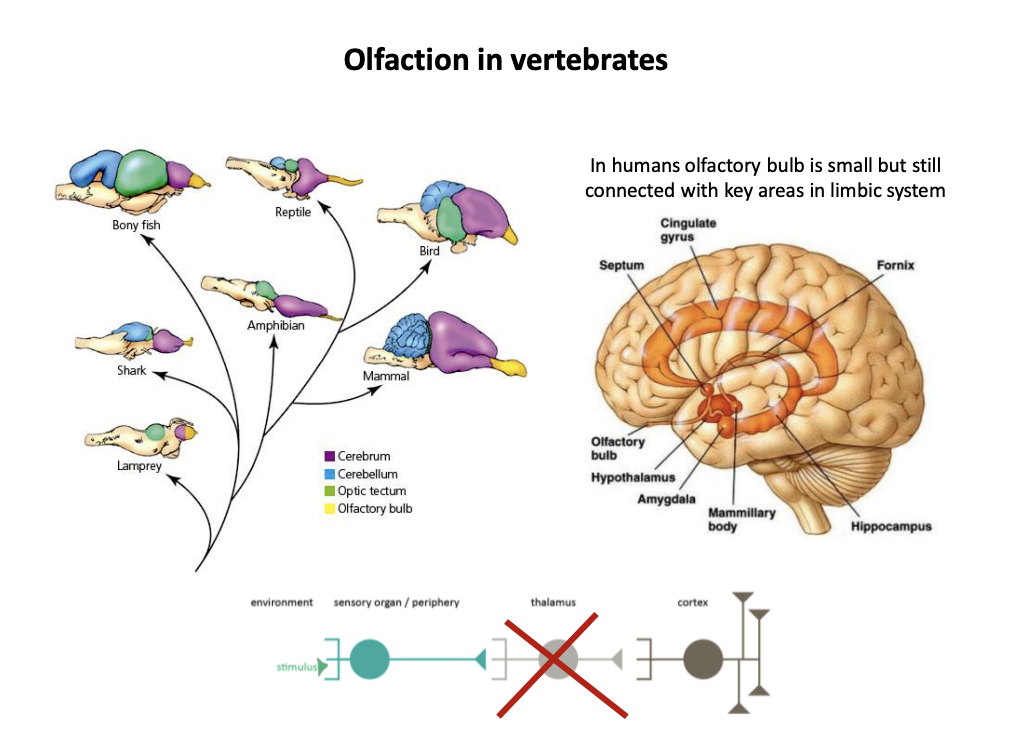
Strucutre of the olfactory epithelium
cillila
lies in layer of mucus
in contact withthe air
axon arise from the cell ody and passes through perfoation in the base of the skull to rach the olfactory bulbs in the brain
THEREFORE→ olfactory recepors cells are long receptors
one expressed per cell!
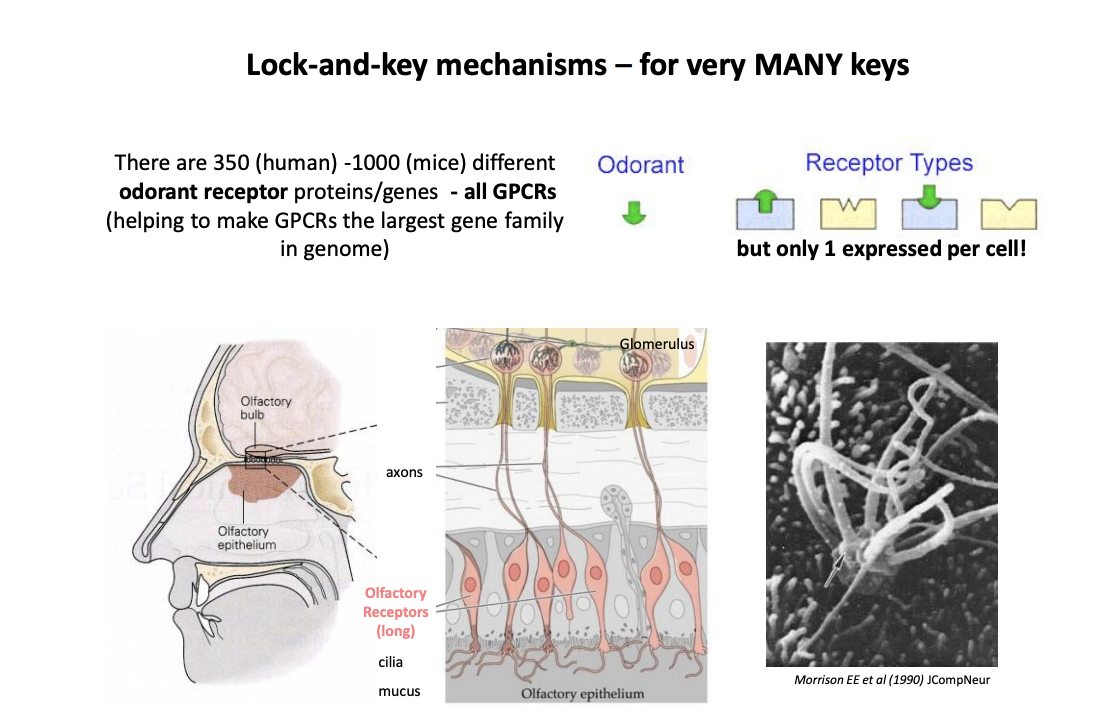
What happens when they die?
repeatedly replaced
thorughout lifetime from quiescnet stem cells
How connected differently to the brain than photoreceptors?
main basic connective it to the limbic sysem
does not pass the thalamas
fast at evoking emotions and memories
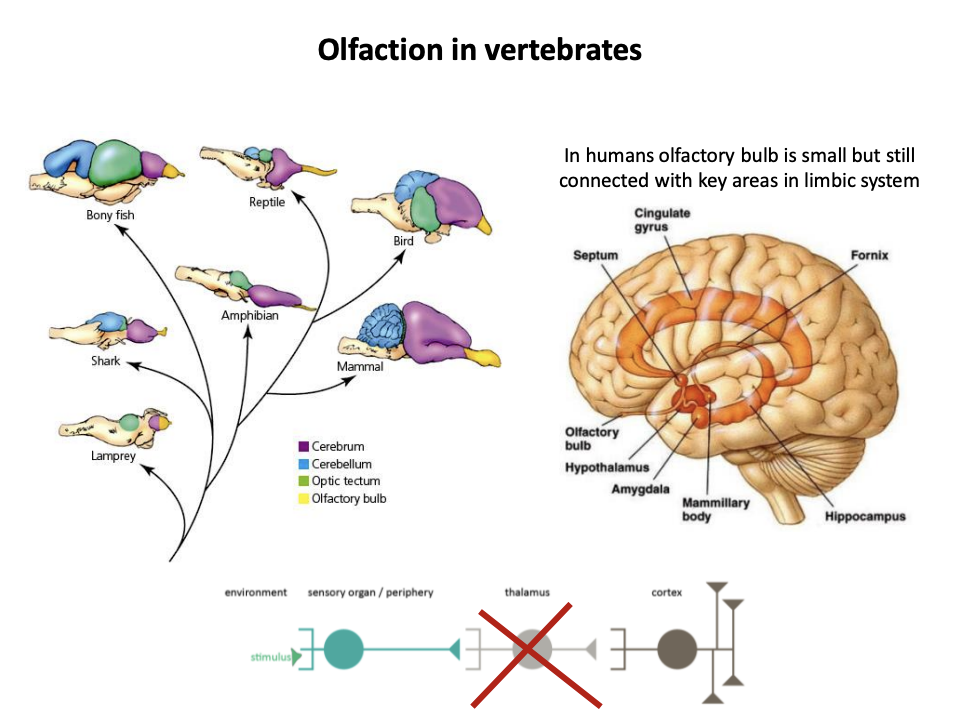
How to smell?
air-borne volatile odorant molecules dissolve in the mucus
bind to receptor proteins in the cillia and recepto cells
350 different odorant receptor proteins
Type of receptor proteins?
all GPCRs
encoded by different gene
helping to make the GPCR family the largest gene family in our genomes
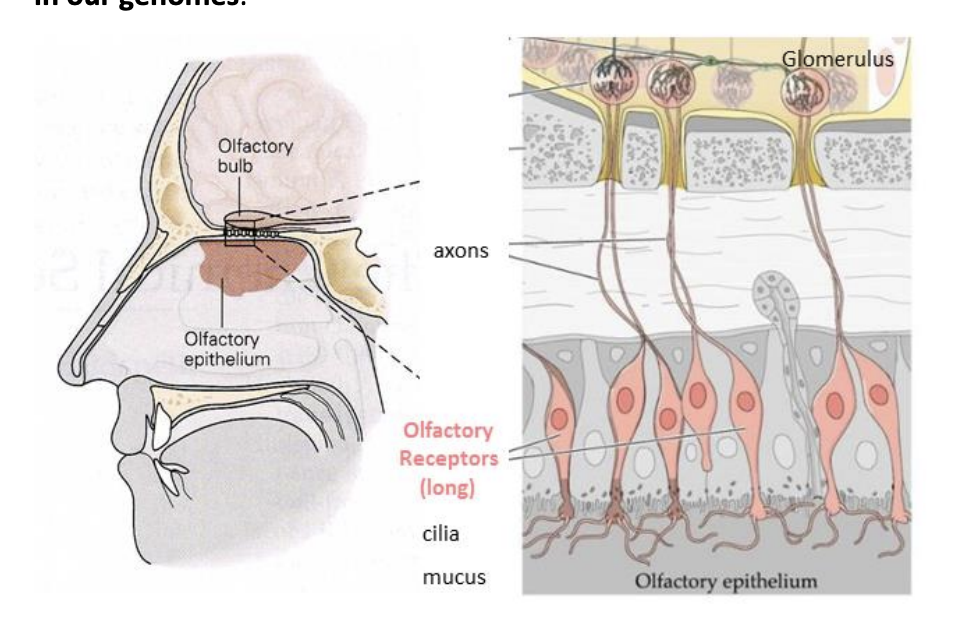
Olfactory transduction
GPCR activated G-protein Golf within the cilia membrane
single activated GPCR molecule may activate more than one G-protein→ AMPLIFICATION 1
each alpha subunit activates one adenyl cyclase→ synthesises more molecules of cAMP AMPLIFICATION 2
cAMP activates cyclic nucleotride-gasted (CNG) channels
open to allow the entry of Na+ and Ca2+→ leading to depolarisation
initiate action potential in the axon
Phosphodiesterase PEDE degrades the c-AMP to AMP→ to end the sensory response
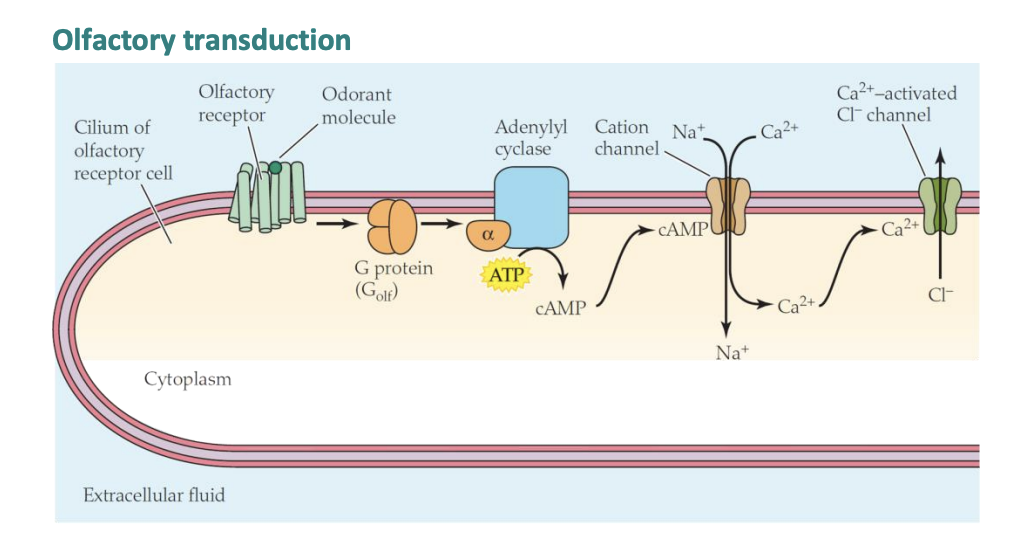
Apart from receptor potential depolarisation, the Ca2+ also
Is a second messenger:
Ca2+ binds to Cl= channels
open to allow Cl- efflus
→unusual efflux negatively charged Cl- enhances the depolasiration
Also leads to adaptation→ similar to photoreceptors!
Ca2+ enters via channels→ leads to adaptation
modulating the activity of different steps in the transduction cascade
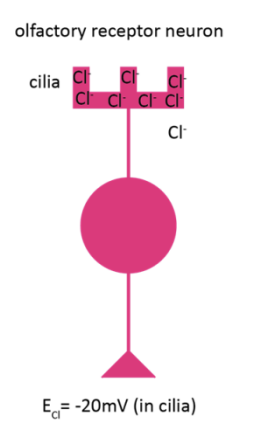
Why does this occur
occurs because a secondary active trasnport system (NaCCK cotransporter)
makes the Cl- concentration within the cilila particulalrly high
occurs because a secondary active trasnport system (NaCCK cotransporter) makes the Cl- concentration within the cilila particulalrly high
Compare & contrast:
note the similarities and differences with phototransduction – the main differences being that cAMP is used rather than cGMP and that the Golf activates a cyclase rather than PDE, so that CNG channels open instead of closing.
How can a few receeptors in the olfactory epithelium encode for millions of chemicals present in the environment?
each receptor cell expresses copies of only one of those receptor proteins
all receptor cells expressing the same odorant receptor protein project the same glomerulus in the olfactory bulb
A given receptor protein might bind specificically to a small subset of odorants
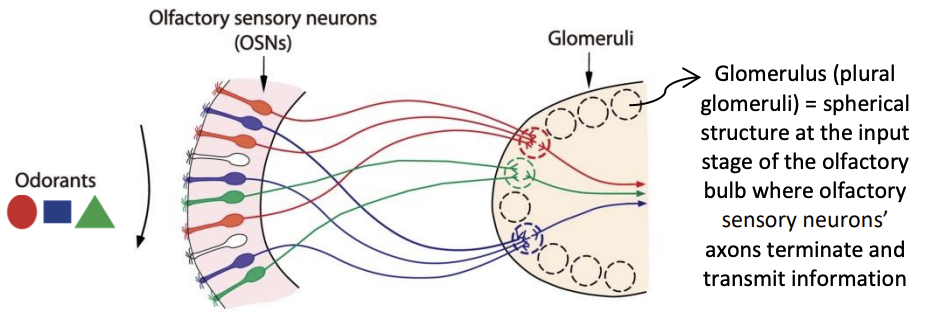
What happens when an odorant bind to several different receptor proteins with different ‘sides’ of the molecule
a given chemical or mix of chemicals might stimulate a unique subset of 350 different receptor proteins/cells/ gloermuli
forms the basis of a powerful ‘combinatorial code’
Allows humans to dicriminante at least millions of olfactory stimuli
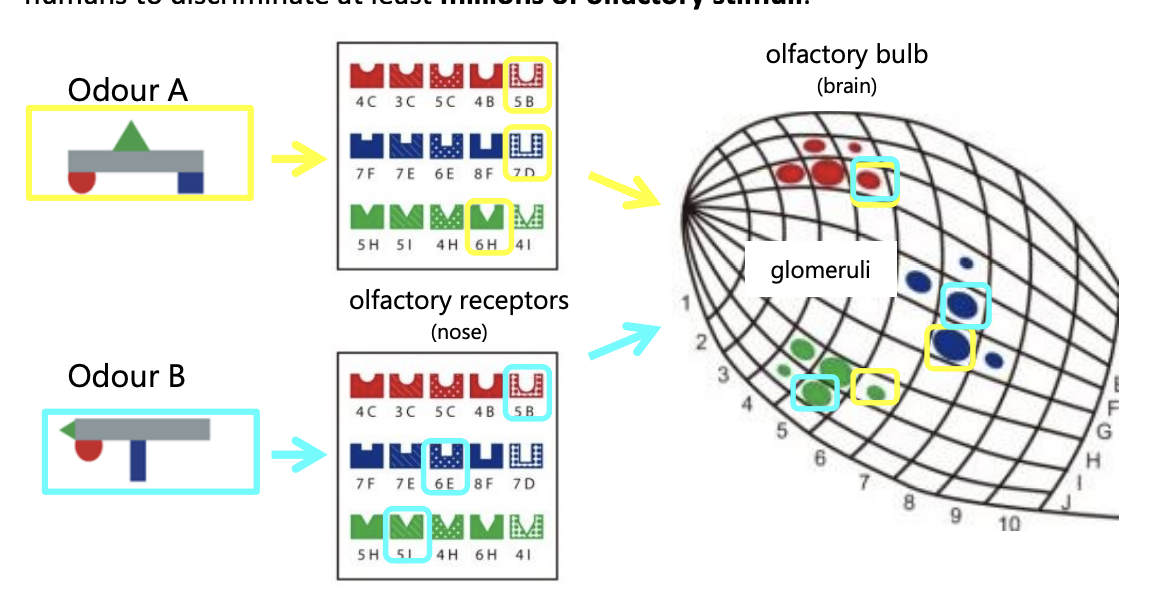
Pheromones to the olfactory system?
No, different to the the detection of colatile chemicals
sense with vomero-nasal organ (VNO) near the regular olfactory mucosa
What does the vomero-nasal organ do
sends info to the accessory olfactory bulb (AOB)
creating parallel system to the olfactory epithelium (main olfactory bulb)
Controls innate behaviours such as mating, parenting and fighting
What are the receptors in the VNO
GPCR odorant receptors
VRs→ vomeronal receptors, detect pheromones
TAARs (Trace amine-associated receptors)→ detect proteinaceous prey/predator chemical cues
Aimilar transduction but ultimately target different areas in the the brain

Humans use pheromones?
mice have 150 pheromone detecting VR genes
HUmans→ only 10→ most are non-functional pseudogenes
vestigial VNO at best